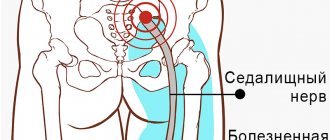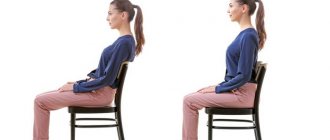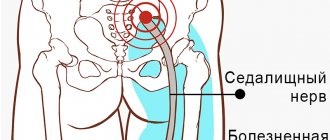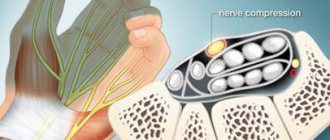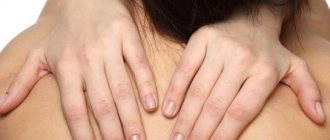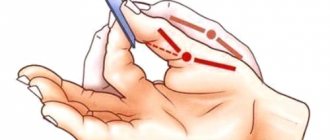Does the pudendal (genital) nerve and its damage differ from similar pathologies in other “regions” of the body?
Yes, the nature of the pathology is different in that the pudendal nerve serves the pudendal area - the genital area, the structure of which is different in men and women. The words of one very concentrated boy from the film “Kindergarten Policeman” immediately come to mind, with which he stopped everyone entering the door of the kindergarten: boys have a penis, girls have a vagina.
In men, the concept of external genitalia includes much more structures in terms of number, volume, and area, therefore the pudendal nerve has a more complex and branched structure, while in women, due to the greater “compactness” of the external genitalia, its length is much shorter.
The pudendal nerve is a paired structure formed on both sides of the body also by the paired branches of the sacral spinal nerves, which provides innervation to organs present in both sexes: the perineum, sphincters of the bladder and rectum, as well as the levator ani muscle, but then they begin differences in structure: in women it provides sensitivity and vegetative function of the labia majora and minora and the clitoris, in men it provides the same functions in relation to the cavernous bodies of the penis and scrotum.
In the photo, the same painful area in women is highlighted in yellow.
About the causes and symptoms of functional disorders
For the etiology of damage, the proximity to the ischium, which the nerve goes around entering the pelvic cavity, as well as the relatively shallow depth of the terminal branches under the surface of the skin and mucous membranes of the pelvic organs, are important. Therefore, dysfunction can occur as a result of:
- injuries to the perineal area;
Perineal trauma can lead to more serious consequences - hypothermia of the perineal area;
- pressing against the ischium by the piriformis muscle due to the presence of a volumetric process in the small pelvis, or due to compression between the pelvic ligaments, or due to another reason;
- damage to the formations that make up the sacral plexus or the sacrum itself.
Provoking factors may be:
- horse riding or cycling (frequently or professionally);
- prolonged labor;
- fracture of the pelvic bones (from a fall from a height, in a car or plane accident).
To understand that something is wrong with the genitofemoral nerve is made possible by dysfunctions of the organs located in the pelvis. These may be sensitivity disorders or autonomic disorders.
The first category includes both varying degrees of decrease in sensitivity (up to its complete loss) and an increase in pain to unbearable limits.
Deviations in autonomics are expressed by disturbances in the functioning of glands and other structures containing smooth muscle fibers, in particular, disorders of the mechanism of blood supply to the cavernous bodies of the penis or clitoris.
Trophic disorders of the skin of the perineum, scrotum and peri-anal area can also be a sign of disorders.
In addition to physical factors, the cause of pathology can also be general somatic diseases:
- tuberculosis;
- collagenoses;
- blood supply disorders due to endocrine disorders and vascular accidents or for any other reason.
NEUROPATHY OF THE OPTURATIVE NERVE (n. obturatorius)
The first signs of compression of the obturator nerve are usually pain that occurs in the groin area and along the inner surface of the thigh, in the hip joint.
Usually the pain intensifies with coughing, tension of the abdominal muscles, that is, with any conditions that increase intra-abdominal pressure. In addition, hip extension, abduction, and inward rotation contribute to increased pain.
There may be a feeling of numbness and “crawling” in the middle and lower part of the inner thigh. Later, a zone of reduced sensitivity (hypesthesia) appears in these same areas.
Motor disorders are manifested by weakness of the adductor muscles of the thigh: weakness when bringing the hips together, difficulty in fulfilling the request to put one leg on the other.
Infringement of rights, or neuralgia
It has long been noticed that those who are violated in their rights either scream loudly about this fact, or mutter about it in a low voice until no one hears.
Provoking factors
The situation is exactly the same if the pudendal nerve is pinched in the canal containing it. A canal with a narrowed diameter for some reason (due to bone growths, bone fractures, or for some other reason) puts pressure on the nerve, which leads to predominantly pain of varying intensity.
Compression of the nerve can be caused by its “swelling”, accompanied by an increase in diameter, which causes its discrepancy with the diameter of the enclosing canal.
But the structure of the affected pudendal nerve does not change during neuralgia. Movement disorders do not occur in the same way as loss of sensitivity.
Therefore, neuralgia is exclusively pain of varying nature and intensity.
And pinching of the pudendal nerve can occur in the inguinal canal:
- with varicose veins of the spermatic cord in men;
- due to pathology of the round ligament of the uterus in women;
- due to an inguinal hernia or the occurrence of cicatricial changes after hernia repair.
Pelvic neuralgia, which often accompanies pinched pudendal nerve, can also occur due to:
- trauma during childbirth;
- muscle spasm in the area of the anus, hypertonicity of the piriformis muscle or obturator internus muscle;
- development of oncopathology in the pelvic organs;
- the onset of complications of herpes.
Features of symptoms
Symptoms of this form of neuralgia are chronic pain in the pelvic area, having the following character:
- aching;
- feelings of burning and itching, especially strong in women and especially in a sitting position;
- excessively high sensitivity of the skin of the groin and perineum area;
- sensations of constant discomfort in the area of natural orifices of the body;
- false-obsessive sensation of a foreign body in the genital area.
Against the background of chronic stress, the following sensations may appear from long-term sensations:
- urinary disorders (involuntary act) or pain when urinating;
- dysfunction of the genital organs (pain during coitus);
- bowel disorders (constipation).
Diagnostic criteria and treatment
For diagnosis, symptoms are important - the patient’s sensations, as well as the absence of external manifestations of pathology.
The use of:
- Ultrasound;
- blockade of the pudendal nerve tract.
In the first case, a violation of blood flow through the pudendal artery is detected, in the second - the disappearance of discomfort after manipulation.
The main goals of treatment are: pain relief, elimination of inflammation and restoration of nerve conduction.
Therefore, it is advisable to use:
- anticonvulsants (Gabapentin), which provide pain relief;
- muscle relaxants (Mydocalm), used to relax muscles;
- blockade of the pudendal nerve with a combination of solutions of anesthetics and hormones;
- vitamin complexes (Neuromultivita class);
- physiotherapeutic techniques (electro-, phonophoresis and the like).
To reduce discomfort, vaginal or rectal suppositories with Diazepam and exercise therapy (for massaging the perineal muscles) are used.
If therapeutic methods are ineffective, surgical decompression is used to relieve the injury and symptoms.
Surgical decompression is sometimes the only option
With a slight degree of compression, many people endure for years, allowing the disease to become chronic, which is a big mistake.
Pain in the perineum in pregnant women
Patients often come to the gynecological department of our clinic with the question of why the perineum hurts during pregnancy and how dangerous it is. Normally, such symptoms are associated with the growth of the fetus and its descent. It is typical for the 3rd trimester - it is during this period, due to the development of the child, that there is an impact on the ligaments, nerves and muscles of the mother’s body, which are stretched. However, the occurrence of such symptoms in the early stages may be a sign that there is a high risk of miscarriage.
It is not uncommon for the fetus to put pressure on the nerve that runs nearby. The pain that occurs in this case limits movement and does not stop until the fetus changes position. Modern medicine cannot help in this case.
Perineum hurts before childbirth
Severe pain symptoms that occur over a long period of time are a sign that labor is approaching. It is caused by the expansion of the pelvic bones and other processes of preparation for the process, along with the approach of the fetus to the birth canal.
Perineum hurts after childbirth
Painful symptoms are felt by almost all women afterward, although its strength may vary. It depends on the presence/absence of injuries during childbirth. So, it goes away 3-4 days after birth when it occurs due to swelling and stretching of tissues, and persists much longer with ruptures of the perineum and sutures.
Since there is no limit to indignation, or about neuropathy
In addition to neuralgia, the pudendal nerve can also become the scene of an inflammatory process, then they talk about neuropathy (neuropathy), or neuritis of the pudendal nerve (a term rarely used today).
Neuropathy differs from neuralgia in the presence of structural changes in the pudendal nerve, as well as movement disorders and the possibility of loss of sensitivity, which serves as a reason for indignation and upset of the patient, because we are talking about neither more nor less than the genitals.
What could be the reason?
The cause of the pathology (also called pudendoneuropathy) is the implementation of two mechanisms:
- compression-squeezing of the nerve trunk in the “scissors” of the sacrospinous ligament-piriformis muscle;
- traction due to overstretching of the nerve in the zone of its transfer over the ischial spine.
The first is illustrated by the consequences of long-term or unsuccessful horse riding or cycling (compression by a hard saddle), and the second by the consequences of surgical intervention - for example, when traction of the hip with the use of a perineal fixator, tension occurs on the nerve pressed to the pubic region.
Features of symptoms
The clinic may consist of lesions of the main nerve trunk or signs of involvement of various branches of the pudendal nerve.
When a surgical fixation is used in the perineal area, isolated damage to the dorsal nerve of the penis occurs with anesthesia of the penis and complete disruption of the previously normal erection.
Full restoration of sensitivity can occur within 6 to 18 months after surgery, but restoration of erection can be only partial.
When compressed by a hard saddle, the disorder is felt as transient numbness or the appearance of paresthesia in the genital area.
Both unilateral and bilateral loss of sensitivity may be observed, not limited to the penile area, but continuing to manifest itself also in the scrotum area.
Neuropathies of the pudendal nerve can signal themselves by pain in the lower buttock and in the anus, short-term urinary retention or a disorder of the imperatives to urinate, accompanied by sharp pain when palpated in the projection of the ischium.
In men, an inflamed pudendal nerve manifests itself with characteristic symptoms - paresthesia or hypoesthesia and pain in the peri-anal area, in the area of the penis and scrotum.
Diagnosis and treatment methods
The main diagnostic criterion is that the pull of the knee towards the opposite shoulder causes pain in the buttock (due to stretching of the sacrospinous ligament).
A simple diagnostic method is to pull the knee towards the shoulder
The clinic is confirmed by electromyography, noting the lengthening of the anal reflex, which closes on the pudendal nerve trunk, as well as a test blockade with the introduction of a novocaine solution into the area of the ischial spine.
The choice of treatment method depends on whether the process is advanced or in an acute stage.
Thus, all the symptoms disappeared in a group of cyclists on their own, after they agreed to refrain from cycling for a month. In case of chronic neuropathy, long-term restorative therapy is necessary.
In chronic cases, methods of drug therapy in combination with rational exercise therapy and physiotherapy are applicable.
Drug therapy includes the use of anti-inflammatory drugs (glucocorticoids Prednisolone, Triamcinolone, Hydrocortisone) in combination with anesthetics (Novocaine 0.5 or 1%) in the form of blockades. A case of relief of pain that had been observed for 14 years after a course of perineural administration of Triamcinolone is described.
Blockade is an effective method, the injection point is indicated with a finger
Pure novocaine blockades are usually less effective.
In order to relieve pain, suppositories of a combined formulation with anesthetics, sedatives and antispastic compounds, both rectal and vaginal, are used.
Vitamin therapy (administration of vitamin C and group B in adequate doses) is especially effective in combination with physiotherapy techniques (various methods of heat therapy), while exercise therapy allows you to increase the capabilities of muscles spasmed by pain and helps to increase the overall tone of the body.
Surgical intervention is applicable if there is no effect from treatment with therapeutic methods.
You should be extremely careful in the case of neuropathy of oncogenic etiology.
Methods for treating pinched and damaged femoral nerve
It is always necessary to begin treatment for a pinched femoral nerve by eliminating the cause of the development of this condition. If the factor that compresses the nerve fiber is not eliminated, then there is no point in carrying out therapy.
Therefore, during the initial diagnosis, the doctor must determine what is compressing the nerve and try to remove this influence using manual therapy. If these are tumor processes or hernias of the inguinal area, then an emergency consultation with a surgeon is indicated. You may need prompt assistance to remove these tumors. Unfortunately, without this it will not be possible to restore the functionality of the femoral nerve.
In the future, if the femoral nerve is damaged, restorative therapy is carried out. It includes:
- massage and osteopathy, which improve microcirculation of blood and lymphatic fluid, which has a positive effect on tissue trophism;
- traction traction of the spinal column is used if the cause of this disease is compression of a certain area of the lumbosacral spine;
- reflexology or effects on biologically active points on the human body, allows you to trigger the mechanism of spontaneous restoration of the damaged area of uneven fiber;
- laser exposure helps relieve swelling and inflammation;
- Therapeutic gymnastics and kinesiotherapy speed up the healing process, increase the overall tone of the body, and strengthen muscles.
The course of treatment is always developed individually. The doctor takes into account the patient’s age and the presence of concomitant health problems. Therefore, if you need medical help, we recommend that you attend a free consultation. neurologist in our manual therapy clinic.
Preventive measures
When riding a bicycle or horse professionally, you should take precautions and follow a routine with mandatory breaks.
Implementing traction for a hip fracture requires the use of a perineal fixator with an adequate support area (up to 9 cm) with a mandatory softening pad.
Intramuscular injections of Magnesium sulfate solution in large doses require caution to prevent the occurrence of ischemic necrosis of the gluteal muscles.
If painful sensations in the pelvis, perineum and genitals appear, and even more so if they increase, you must immediately seek help from a neurologist.
What diagnostics are performed for pain in the perineum?
Often, when pain symptoms occur in the perineum, the patient does not know which doctor he needs to see. First of all, you should make an appointment with a therapist who, depending on the situation, will give a referral to a urologist, gynecologist, proctologist or surgeon. Diagnostic methods in all cases are specific, the main ones are the following:
- interviewing the patient to determine the nature of the pain and the presence of additional symptoms;
- physical examination by a gynecologist or urologist;
- careful history taking;
- general and biochemical blood test;
- general urine analysis;
- bacterioscopy in women, urethral flora smear in men;
- radiography;
- ultrasonography;
- intestinal colonoscopy;
- examination of the rectal mucosa;
- computed and magnetic resonance imaging;
- X-ray of the colon of the bladder with the introduction of a contrast agent into it.
NEUROPATHY OF THE EXTERNAL CUTANEOUS NERVE OF THE FEMOR (n. cutaneus femoris lateralis)
This is a sensory nerve; it is responsible for sensitivity in the area of the outer (lateral) thighs.
Neuropathy is manifested by burning persistent pain in the area of the outer surface of the thigh and a feeling of numbness, “crawling”, tingling in the same area.
These phenomena intensify when standing up and walking.
People suffering from neuropathy of the external cutaneous nerve of the thigh describe pain when standing up as a flashing, “ball of fire” in the lateral thigh area and spreading down the thigh, before reaching the knee.
The pain point for this type of neuropathy is detected under the anterosuperior iliac spine.
SYNDROME OF "CAUSALGIA OF THE INGUINAL-GENITAL AREA"
This syndrome develops with damage to the iliohypogastric (n. iliohypogastricus), ilioinguinal (n. ilioinguinalis), and genitofemoral (n. genitofemoralis) nerves.
The function of all three of these nerves is to provide sensitivity to the skin in the groin area.
Neuropathy of each nerve can occur separately, but the similarity of their anatomy and clinical manifestations makes it possible to combine their damage into a single syndrome - the “causalgia of the inguinal-genital zone” syndrome.
The main complaint is burning pain in the groin area, spreading along the front surface of the thigh and along the abdominal wall. The pain intensifies when the muscles of the anterior abdominal wall are tense - when straining, when walking with long steps, when hyperextending the lumbar spine.
Sometimes a gentle gait is observed: a person moves in small steps with a lean forward, which reduces abdominal tension and, accordingly, pain.
An additional diagnostic test is to apply pressure to a point located slightly to the center of the anterior superior iliac spine. In this case, the pain characteristic of this syndrome is reproduced.
